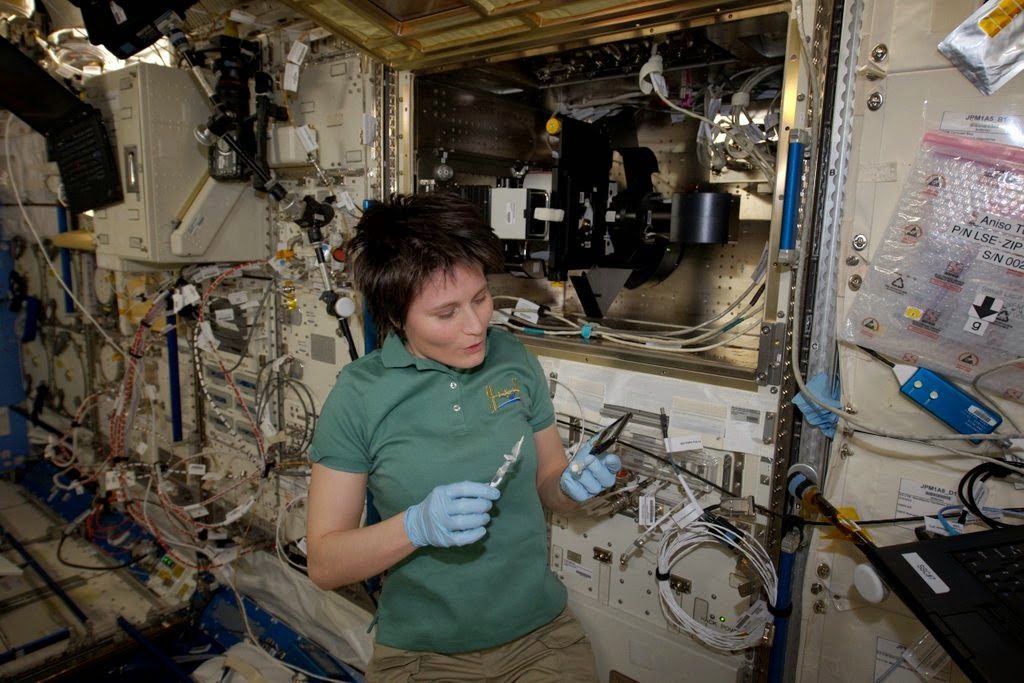Yesterday was a relatively easy day, which is always kind of nice at the end of the week. Not that I didn’t have a full schedule – we always have activities from our morning Daily Planning Conference, or DPC, (somewhere around 7:30 in the morning) to our evening DPC (somewhere around 19:30). However, tasks can be more or less complex and more or less “routine”.
Running a new experiment that has not been performed before, which requires a complicated setup, a lot of coordination with the ground or delicate operations is of course a lot more demanding than performing tasks that I have done before and that I can perform autonomously – let’s say sampling the water or removing/installing lockers in our Express racks (modular racks that can support a variety of science operations and are continuously reconfigured depending on current and upcoming ops).
Simple or routine tasks that do not require a lot of support from the control centers are usually inserted in our schedule as “pink activities” – the writing is pink on our planning viewer, indicating that you can do them whenever you want, as long as they are done by the end of the day.
For non-pink activities, on the contrary, there is an expectation that they be performed more or less on time. Some tasks are even “blue-boxed” – a thick borderline around the activity on the viewer indicates that the time is to be strictly observed. Typical blue-boxed activities are live interviews with media or public calls with VIPs, which require a complex setup on the ground to provide audio and video connection with the party on the other side for the agreed time.
Most experiments are not blue-boxed, but they are also not pink. That’s because very often specialists very familiar with the experiment operations, and sometimes the principal investigator himself/herself, are available on space-to-ground for any assistance or real-time troubleshooting that might be required. In many cases, you don’t get a second chance to get an experiments right (at least not until you fly up new samples or equipment), so it’s important to have the maximum support available in case problems are encountered.
Talking about science, today I worked a little bit with the JAXA experiment ANISO tubule. I’ve performed several runs of this experiment, each one consisting (from my side) of a sequence of activities spread over multiple days.
Let’s say that today is day 1: you retrieve a new sample chamber, like the one in the pictures, and with a syringe you slowly inject 1,5 ml of water. Then you put the chamber in MELFI for 96 hours at +2C! This simulates winter and promotes good germination of the Arabidopsis seeds. Then the chamber is moved to ambient temperature for about 4 more days (spring has arrived!) and finally, after adding more water, two days of observation in the fluorescence microscope begin, with scientists on the ground directly studying live images from ISS.
We have known for a long time that plants grow differently in weightlessness. Since they don’t “feel” gravity up here, they tend to grow a thinner and longer stem. In fact, the ANISO scientists have even done the opposite on the ground, putting seeds in a centrifuge and showing that in “hypergravity” they grow shorter and thicker stems. The difference is likely due to different orientation of microtubules in the individual cells that change their shape. I find it fascinating that something as small as a cell would be affected by gravity, but it is!
A particular group of proteins, called MAPs, control the orientation of the microtubules and hence the shape of the stem. Now, you can’t really see microtubules and MAPs directly in the fluorescence microscope, but these Arabidopsis plants have been engineered in such a way that they also produce a fluorescent protein that accurately mimic MAPs: and that does the trick! Now you can use the fluorescence microscope to indirectly observe proteins that you otherwise would not see. Fascinating, isn’t it?
Sounds a bit paradoxical, but microgravity is really a great place to study gravity response of plants, which in turn can help optimizing agricultural practices. I don’t have a background in life sciences, so this is all very new to me, but I hope you find it as intriguing as I do!
Futura mission website (Italian): Avamposto42
avamposto42.esa.int
(Trad IT) Traduzione in italiano a cura di +AstronautiNEWS
qui: https://www.astronautinews.it/tag/logbook
(Trad FR) Traduction en français par +Anne Cpamoa ici: https://spacetux.org/cpamoa/category/traductions/logbook-samantha
(Trad ES) Tradducción en español por +Carlos Lallana Borobio
aqui: https://laesteladegagarin.blogspot.com.es/search/label/SamLogBook
(Trad DE) Deutsch von https://www.logbuch-iss.de
04/04/2015





